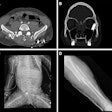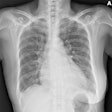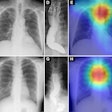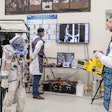An investigation by the U.S. Department of Veterans Affairs (VA) of a VA hospital in Salt Lake City found evidence of "tension" between interventional radiologists and vascular surgeons, but reported that the situation did not "directly contribute" to the deaths of four patients at the facility within a nine-month period.
In a report released on December 28, the VA's Office of Inspector General said that "tensions" and "poor collaboration" between interventional radiologists (IR) and vascular surgery (VS) residents at the VA Salt Lake City Health Care System may have compromised patients but did not "directly contribute" to the patient deaths.
But the report added that "lack of a cohesive team approach" between the two specialties resulted in delays in care for two patients and caused two of the patients to receive "less than optimal vascular care."
Tensions within the facility diminished after changes were made in the way the hospital manages patients who need vascular surgery, concluded Dr. John D. Daigh Jr., assistant inspector general for the VA, who authored the report.
Tension between IR and VS
The Office of Inspector General (OIG) launched the investigation after receiving a complaint that charged that four patients died from "inappropriate vascular care" at the hospital. The complainant specifically attributed the deaths to a "lack of collaboration" between vascular surgery and interventional radiology physicians, and also charged that unwarranted amputations were occurring at the facility.
The report noted that patients requiring vascular care are managed either by interventional radiology or vascular surgeons. Tensions between the two disciplines began rising in July 2008, however, when the University of Utah started a vascular surgery fellowship at the VA hospital with the goal of increasing vascular surgery's access and training in endovascular procedures, the report noted.
The incidents resulted in systemic changes to the way patients are treated. All patients requiring endovascular procedures at the medical facility are now managed exclusively by vascular surgeons, while those needing nonvascular interventional procedures are managed by interventional radiologists, the report stated. The changes have resolved the tensions between interventional radiology and vascular surgery, the report concluded. The chief of interventional radiology during the period covered by the report, Dr. Laura Findeiss, resigned in July 2009.
Patient deaths
The OIG's report focused on the four patient deaths that occurred between August 2008 and May 2009. The first patient, a man in his 50s with a history of vascular disease and a femoral arterial bypass graft, first presented to the vascular surgery clinic in March 2008 with leg pain. Interventional radiologists placed a stent for recanalization of his left external iliac artery, but he quickly showed signs of distress.
Because interventional radiologists had no admitting privileges at the system, the IR resident contacted the surgery resident to admit the patient; the surgery resident said the IR resident would have to call the university's vascular surgery resident on call. After the patient was finally admitted, an angiography showed a leak in the left external iliac artery and he underwent evacuation of an intra-abdominal hematoma and vascular surgical repairs. He died a short time later.
That patient's death in August 2008 led to an apology to the man's family and a two-week moratorium on vascular surgeries and IR procedures, the report noted. The report faulted the interventional radiology resident for not communicating the urgency of the situation to the vascular surgery resident.
The second patient, a man in his 70s, presented to the facility in October 2008, also for leg pain due to poor circulation. An angiogram and intervention were performed; however, a short time later, his foot pulses were absent. The interventional resident recommended monitoring; the vascular attending physician recommended surgical intervention.
An ultrasound showed a clotted left superficial femoral artery, and an IR physician initiated thrombolytic therapy. The vascular resident noted progressive bilateral clinical ischemia, and the patient underwent emergent vascular surgery on the right leg as well as amputation of his left leg above the knee. The man died the next day.
The patient received "less than optimal care management," the report concluded, citing "lack of collaboration between [vascular surgery] and IR" as contributing factors.
The third case involved a man in his 80s with a history of end-stage renal disease who also had major artery surgery for both legs. The patient presented to the emergency department in February 2009 with a pulsatile mass, and CT showed a large abdominal aortic aneurysm (5.5-6 cm).
The interventional radiologist preferred managing the patient in a less invasive manner, while the vascular surgeon recommended surgical repair. The patient underwent open surgery but suffered a postoperative heart attack. He became weaker and did not want to eat.
A few days later, the patient wished no further treatment and chose to be discharged home. However, his condition declined rapidly, and he died before being discharged.
The report found his care was "consistent with community standards," noting his decision to withdraw treatment.
The fourth patient was a man in his 60s who had had a coronary artery bypass graft, peripheral vascular disease, and glomerulonephritis. He presented in May 2009 with graft-threatening narrowing in his left femoral-peroneal bypass graft. Vascular surgeons initiated an antibiotic regimen for the aneurysm and pneumonia after admission. After repeatedly declining any imaging or invasive procedures, the patient finally agreed to an MRI and CT scan of the abdomen, which showed a large periaortic lesion and development of a large aneurysm.
After he finally agreed to surgery, vascular surgeons said the patient's need for bypass during urgent repair of his large abdominal aneurysm exceeded the capabilities of the VA hospital, and they recommended transfer to the university. The patient was transferred but died two days later of a ruptured aneurysm before surgery was performed.
The report concluded that care was "consistent with community standards," noting the patient resisted diagnostic testing and delayed surgical intervention.
Increasing amputations
Although the report concluded that "poor collaboration" between interventional radiology and vascular surgery occurred in two of the four cases, this did not directly contribute to the patient deaths, the OIG's report states. The Salt Lake City VA system also "took appropriate actions to review the quality of care and make system improvements" before and during the OIG's investigation.
Regarding complaints that the facility had a higher occurrence of unwarranted amputations after July 2008, the report noted that VA records show a nearly fourfold increase in the number of amputations conducted between 2007 and 2009 at the Salt Lake City VA. Vascular surgeons performed 22 amputations in 2009, compared to 10 in 2007 and six in 2008.
However, the inspector attributed the rise to an increase in the number of surgeons and patients in the system, and the OIG's report made no recommendations regarding this issue.
The investigation also found no evidence of inappropriate management of vein patients by vascular surgeons, another allegation by the complaint.
Officials at the VA medical center did not respond to calls for comment.
By Donna Domino
AuntMinnie.com contributing writer
January 8, 2010
Related Reading
VA lowers estimate of patients affected by brachytherapy mistakes, December 21, 2009
NRC report cites Philadelphia VA, November 19, 2009
6 more botched prostate brachytherapy cases at Philly VA, August 18, 2009
Congress eyes safety of VA prostate brachytherapy: Part 2, August 10, 2009
Congress eyes safety of VA prostate brachytherapy: Part 1, August 6, 2009
Copyright © 2010 AuntMinnie.com



















